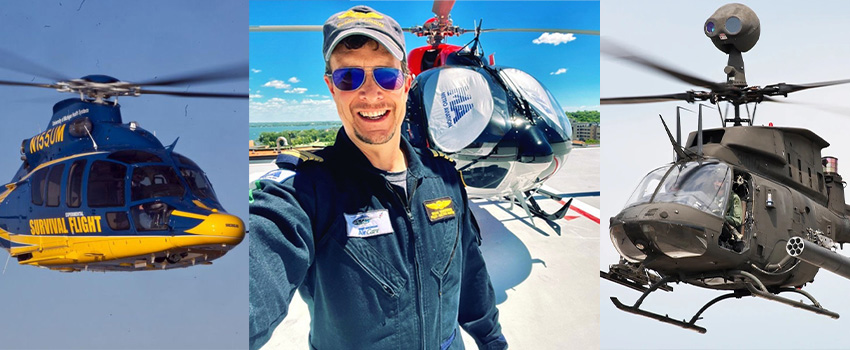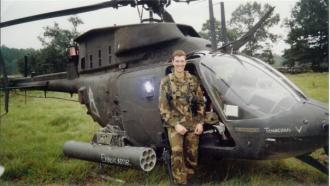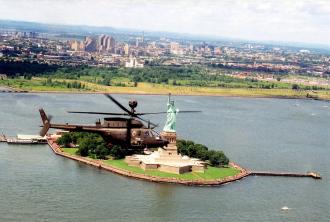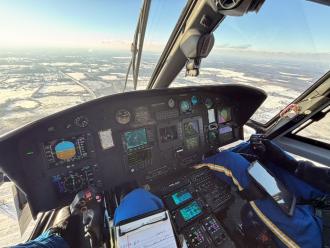From Army Skies to Life-Saving Flights: The Journey of Brian Vanderberg

Ever watch one of those emergency helicopters sit down at a hospital complex and wonder who the pilot is?
Well, one of those "who's" is Brian Vanderberg, a 1991 graduate of WMU's aviation program, and he's been at those controls for almost a quarter of a century.
A Kalamazoo-area native and a member of the class of 1986 at Portage Central High School, Vanderberg used a seven-year stint in the U.S. Army as a catapult to his civilian career that began in 2002.
Shortly after he received his bachelor's in Western's program to train professional pilots, Vanderberg sampled work in the air at a grass-strip airport near Napoleon, Mich., taking sky divers up aboard a single-engine Cessna. Far from satisfying and not exactly a bank-account fertilizer, aviation and Vanderberg were not bunkmates for a short time.
Then "a friend of a friend" who happened to be participating in the WMU ROTC program suggested that Vanderberg had what it takes to join the Army's Warrant Officer Flight Training initiative. He applied and was accepted.
From July of 1995 through April of 1997, Vanderberg got up close and personal with all kinds of helicopters, their military versions, and strategic tactics. That qualified for being assigned to the 10th Mountain Division based at Ft. Drum in northern New York state. Large-scale training exercises took him to Ft. Polk in Louisiana three times.
"I relied heavily on the basic airman skills I had learned at WMU," he says, "when tasked with leading the planning for flying eight helicopters from upstate New York to Louisiana. Many of the aviators in my unit had never operated outside of the Army environment and were unfamiliar with planning a cross-country flight. It was a very proud moment for this young aviator to be asked to lead that planning and to represent WMU." Vanderberg wrapped up his military career as a helicopter-pilot instructor at what was then Ft. Rucker in Alabama.
"I think my favorite time in aviation was when I was stationed at Ft. Drum," he says. "The high level of dedication and camaraderie was amazing. Working with other dedicated pilots was quite an experience. Formed life-long friendships and a network that I can still call on."
Like many a veteran, Vanderberg applied what he had learned well in the military to his civilian status. In 2002, he started flying an EMS helicopter serving hospitals in Toledo, Ohio, and along the way qualified to pilot models of the AS356 Dauphin, a multi-purpose, twin-engine chopper made in Europe.
When Kalamazoo's Bronson and Borgess hospitals ascended into the realm of EMS helicopters through West Michigan Air Care, Vanderberg in 2007 jumped at the chance to return to his home area and take advantage of the Kalamazoo Promise (financial support for higher education and technical training) for his growing family.
During his Kalamazoo sojourn, the service evolved into being contracted to Metro Aviation Inc., which required a qualification in a new airframe.
"This provided some great opportunities from time to time," he says, "to fly to other Metro bases that were short-staffed for pilots," taking him to Wisconsin, Cleveland, South Bend, North Carolina, Philadelphia and back to Toledo.
"With Metro Aviation," Vanderberg says when Bronson and Borgess ended helicopter service in 2024, "I had plenty of opportunities to go to other bases it operated across the country, but after discussions with my wife, we decided we wanted to stay in Michigan. The only other contract Metro had in the state was with University of Michigan Survival Flight. Until it had an opening, I served as a float pilot to cover bases that were chronically short-staffed."
That status ended in December of 2024 and he now flies the EC155B1, a twin-engine craft that can accommodate its share of passengers, for U of M Survival Flight.
Vanderberg's affinity for aviation stems from childhood. His father was an Air Force veteran and an enthusiast for all things flying. "We would marvel at the machines of the sky through magazine subscriptions and air shows. I think my path was decided when he took the family to the aviation extravaganza in Oshkosh. It was such an engrossing experience, and I knew that the aviation environment was where I wanted to be. Hopefully, to be a pilot, but any facet would do as long as I could be around airplanes."
If that verve ever waned, there was also a daily reminder. "Growing up near the Kalamazoo airport," he says, "I was privy to view a lot of air shows, the warbirds at the Kalamazoo aviation museum, and airline traffic. I was always pausing to watch them flying over our house."
While Vanderberg did take a look at aviation programs around the country, there was one in his backyard that was highly regarded. "WMU was close to home and a great value financially," he says.
And he was no campus shrinking violet. He was affiliated with Western's hockey team, sharpening skates and performing other behind-the-scenes tasks needed to get the Broncos out on the ice. Visitors to the Lawson Arena can spot Vanderberg in the 1986-87 team photo that is hanging in the hallway. And, of course, there were the pickup hockey games that always seemed to develop.
Closer to his career choice was his membership in the WMU Sky Broncos, serving two years as the student organization's treasurer. "I saw it transition from being the entity that did the private-pilot flight instructions (now done by the university)," he says, "to being a conduit for aircraft rentals at Western (and at a very nice rate) to being now a social club/flight team entity."
Want some more? How about working as an on-air disc jockey at the student radio station --- WIDR. "That gave me a glimpse into the worlds of communications majors," he says, "interfacing with staff at the station and the Western Herald student newspaper. I gained an understanding of what goes into producing a publication and running a radio station, how committees function, and how independent parts must be in sync to meet organizational goals.
"All this set me up well in the Army," he says, "where a myriad of additional duties is required to be conducted in order for the unit to be successful in the field." And successful he has been and he plans to stay the course. "My long-term goal in aviation is to continue flying," Vanderberg says. "I still enjoy being in the cockpit and the thrill of flying. Though at this stage I appreciate more what it takes -- and has taken -- to get an aircraft into the air. I'm not ready to transition into management quite yet."
There's a solid reason for that, and it has to do with Vanderberg's perspective. "I'm part of a team that is showing up on someone's worst day of their life," he says, "and getting them to a place that gives them a chance to have better days, while working alongside some truly dedicated flight nurses, medics and in some cases, doctors."
He admits that the transition from military flying to the civilian workforce had its challenges, and it took him some time to "understand the landscape of the EMS industry." There was a skill adjustment as well. In the Army, he flew single-engine "birds" while twin-engine jobs were the choppers of choice for that phase of health care.
"The universal challenge faced by those in aviation," he says, "is the demands of the job. Aviation work hours do not conform to the normal 9-to-5 workday, and that can stress your health and relationships. Everything revolves around getting the bird in the air, and it takes a lot of effort from many people to accomplish that. That effort is not without some sort of sacrifice."
But it's been worth it for Vanderberg. He and his wife, Lisa, have relocated from Kalamazoo to Grass Lake, Mich., because of the new assignment. One son is working offshore in the North Sea maintaining a wind farm while the other is finishing his studies at Michigan Tech.
While most of us try to minimize the ups and downs of life, it's no big deal for Brian Vanderberg. He does those "ups and downs" every day.












